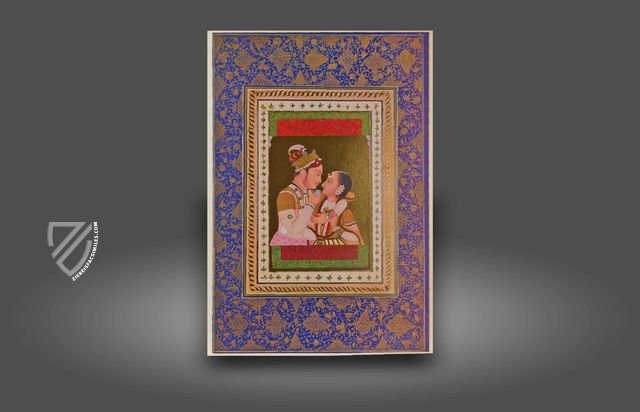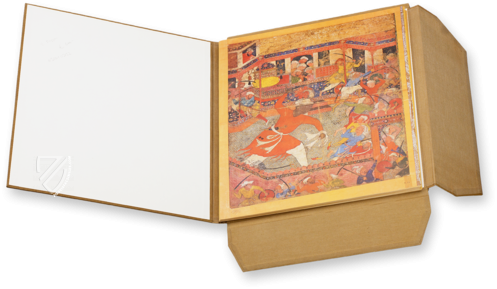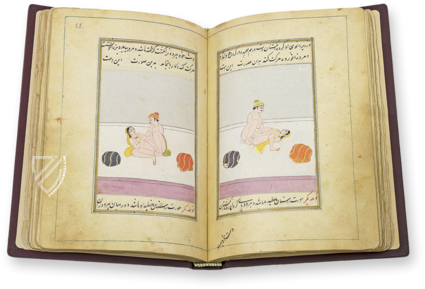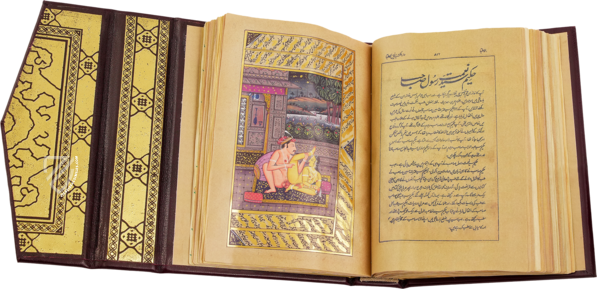Art of the Moghul Era
(under 1,000€)
The Moghul dynasty ruled over most of the Indian subcontinent for more than three centuries. Their empire was not only the world's richest state in the modern era, but also developed its own unique artistic style. Mughal painting combined the older Indian artistic tradition with Islamic, Persian and even Chinese influences, resulting in a particularly refined and elaborate aesthetic. This continued to have an impact on subsequent art styles, especially in northern India. This collection of ten gorgeous full-page miniatures offers a wonderful insight into this rich and diverse artistic tradition from the period between the 16th and 18th centuries. The very varied depictions allow the beholder to appreciate the artistic approach to human and animal figures, which are often found in beautiful, dreamy landscapes.
Art of the Mughal Era
Founded in 1526, the Mughal Empire was an Islamic superpower that ruled over most of the Indian subcontinent and parts of Afghanistan for 325 years. The ruling class could trace their roots to both Genghis Khan (ca. 1162–1227) and Timur (1336–1405) also known as Tamerlane, but became increasingly Indian and Persian due to dynastic marriages. At its height, Emperor Aurangzeb (1618–1707) ruled over one quarter of the world’s population as well as the largest economy in the world with a GDP ten times that of France under Louis XIV (1638–1715). This tremendous wealth, when paired with the massive polyglot population, produced a rich cultural and artistic heritage. It evolved from Persian miniature painting, which was itself heavily influenced by Chinese art, in addition to influences from the Hindu, Jain, Turkic, and Buddhist artistic traditions. It is distinguished from its Persianate predecessors by adopting a more realistic style for plants, animals, and portraits. Other elements of the Persian artistic tradition, especially richly-decorated borders, were continued and refined. Art from the Orient was a source of great fascination in Early Modern Europe. When Rembrandt's art collection was auctioned off in Amsterdam in 1656, the first album with Indian miniatures found in Europe was among them. The ten folios assembled here represent are from this historic and exotic collection. Each of the original facsimile edition pages consists of two parts: an interior piece with the actual scenic representation and matting richly ornamented with gold and silver.
The ten folios assembled here represent a splendid sample of this rich, diverse artistic tradition created between the 16th and 18th centuries:
1. Emperor Akbar Tames an Elephant, 1609/10
2. Imperial Hunting Falcon, 1st quarter of the 17th century
3. Mughal Ladies on the Lakeside Terrace, 3rd quarter of the 18th century
4. Loving Couple on the Harem Terrace, 2nd half of the 17th century
5. Mughal Lady in the Harem, 2nd half of the 17th century
6. Loving Couple at the Window, 1st half of the 18th century
7. Princess at the Fireworks, 2nd half of the 17th century
8. The Lady Minstrel, ca. 1580
9. The Resting Prince, ca. 1800
10. Emperor Akbar Gardening, End of the 16th century
Codicology
- Alternative Titles
- Kassette Kunst der Moghulzeit
- Size / Format
- 10 leaves / 38.5 × 26.0 cm
- Origin
- India
- Date
- 16th–18th century
- Epochs
- Style
- Genre
- Language
- Illustrations
- 10 miniatures
- Content
- Ten leaves from important manuscripts
Art of the Moghul Era
A Princess at the Fireworks
This festive miniature shows a princess seated in a golden chair with a Roman candle in hand and surrounded by attendants and other ladies of the court. The artist makes generous use of gold leaf to show fireworks being lit in the palace, on ships in the river, and on the opposite bank as well as rockets exploding in the distance during the celebration of Shab-e-Barat. The seated woman is Princess Zib an-Nisa (1639–1689), an interesting and well-educated personality of the Moghul court who was already a famous poet in her own lifetime.

Art of the Moghul Era
Lovers at the Window
Looking deeply into each other eyes, two royal lovers are pictured in an intimate embrace that is emphasized by the artist who depicts them in a “closeup” as though they were about to share a kiss in a modern movie. Covered in pearls, rubies, and other gems, both figures stand before a burnished gold background symbolizing the intoxicating feeling in which young lovers can often lose all their senses.
European influences can be discerned both in the construction of the scene itself as well the gorgeous purple frame with intricate floral patterns executed in gold leaf that surrounds it. Rather than depicting a specific pair, this is an idealized portrait of a prince with his lover, which is consistent with the traditions of Indian art.

#1 Kassette Kunst der Moghulzeit
Language: German
(under 1,000€)
- Treatises / Secular Books
- Apocalypses / Beatus
- Astronomy / Astrology
- Bestiaries
- Bibles / Gospels
- Chronicles / History / Law
- Geography / Maps
- Saints' Lives
- Islam / Oriental
- Judaism / Hebrew
- Single Leaf Collections
- Leonardo da Vinci
- Literature / Poetry
- Liturgical Manuscripts
- Medicine / Botany / Alchemy
- Music
- Mythology / Prophecies
- Psalters
- Other Religious Books
- Games / Hunting
- Private Devotion Books
- Other Genres
- Afghanistan
- Armenia
- Austria
- Belgium
- Colombia
- Croatia
- Cyprus
- Czech Republic
- Denmark
- Egypt
- Ethiopia
- France
- Germany
- Greece
- Hungary
- India
- Iran
- Iraq
- Israel
- Italy
- Japan
- Lebanon
- Luxembourg
- Mexico
- Morocco
- Netherlands
- Palestine
- Peru
- Poland
- Portugal
- Russia
- Serbia
- Spain
- Sri Lanka
- Sweden
- Switzerland
- Syria
- Turkey
- Ukraine
- United Kingdom
- United States
- Uzbekistan
- Aboca Museum
- Ajuntament de Valencia
- Akademie Verlag
- Akademische Druck- u. Verlagsanstalt (ADEVA)
- Aldo Ausilio Editore - Bottega d’Erasmo
- Alecto Historical Editions
- Alkuin Verlag
- Almqvist & Wiksell
- Amilcare Pizzi
- Andreas & Andreas Verlagsbuchhandlung
- Archa 90
- Archiv Verlag
- Archivi Edizioni
- Arnold Verlag
- ARS
- Ars Magna
- ArtCodex
- AyN Ediciones
- Azimuth Editions
- Badenia Verlag
- Bärenreiter-Verlag
- Belser Verlag
- Belser Verlag / WK Wertkontor
- Benziger Verlag
- Bernardinum Wydawnictwo
- BiblioGemma
- Biblioteca Apostolica Vaticana (Vaticanstadt, Vaticanstadt)
- Bibliotheca Palatina Faksimile Verlag
- Bibliotheca Rara
- Boydell & Brewer
- Bramante Edizioni
- Bredius Genootschap
- Brepols Publishers
- British Library
- C. Weckesser
- Caixa Catalunya
- Canesi
- CAPSA, Ars Scriptoria
- Caratzas Brothers, Publishers
- Carus Verlag
- Casamassima Libri
- Chavane Verlag
- Christian Brandstätter Verlag
- Circulo Cientifico
- Club Bibliófilo Versol
- Club du Livre
- CM Editores
- Collegium Graphicum
- Collezione Apocrifa Da Vinci
- Comissão Nacional para as Comemorações dos Descobrimentos Portugueses
- Coron Verlag
- Corvina
- CTHS
- D. S. Brewer
- Damon
- De Agostini/UTET
- De Nederlandsche Boekhandel
- De Schutter
- Deuschle & Stemmle
- Deutscher Verlag für Kunstwissenschaft
- DIAMM
- Droz
- E. Schreiber Graphische Kunstanstalten
- Ediciones Boreal
- Ediciones Grial
- Ediclube
- Edições Inapa
- Edilan
- Editalia
- Edition Deuschle
- Edition Georg Popp
- Edition Leipzig
- Edition Libri Illustri
- Editiones Reales Sitios S. L.
- Éditions de l'Oiseau Lyre
- Editions Medicina Rara
- Editorial Casariego
- Editorial Mintzoa
- Editrice Antenore
- Editrice Velar
- Edizioni Edison
- Egeria, S.L.
- Eikon Editores
- Electa
- Emery Walker Limited
- Enciclopèdia Catalana
- Eos-Verlag
- Ephesus Publishing
- Ernst Battenberg
- Eugrammia Press
- Extraordinary Editions
- Fackelverlag
- Facsimila Art & Edition
- Facsimile Editions Ltd.
- Facsimilia Art & Edition Ebert KG
- Faksimile Verlag
- Feuermann Verlag
- Folger Shakespeare Library
- Franco Cosimo Panini Editore
- Friedrich Wittig Verlag
- Fundación Hullera Vasco-Leonesa
- G. Braziller
- Gabriele Mazzotta Editore
- Gebr. Mann Verlag
- Gesellschaft für graphische Industrie
- Getty Research Institute
- Giovanni Domenico de Rossi
- Giunti Editore
- Graffiti
- Grafica European Center of Fine Arts
- Guido Pressler
- Guillermo Blazquez
- Gustav Kiepenheuer
- H. N. Abrams
- Harrassowitz
- Helikon
- Hendrickson Publishers
- Henning Oppermann
- Herder Verlag
- Hes & De Graaf Publishers
- Hoepli
- Holbein-Verlag
- Hortus Deliciarum
- Houghton Library
- Hugo Schmidt Verlag
- Idion Verlag
- Il Bulino, edizioni d'arte
- ILte
- Imago
- Insel Verlag
- Instituto Nacional de Antropología e Historia
- Istituto dell'Enciclopedia Italiana - Treccani
- Istituto Ellenico di Studi Bizantini e Postbizantini
- Istituto Geografico De Agostini
- Istituto Poligrafico e Zecca dello Stato
- Italarte Art Establishments
- J. Thorbecke
- Jan Thorbecke Verlag
- Johnson Reprint Corporation
- Josef Stocker
- Josef Stocker-Schmid
- Jugoslavija
- Karl W. Hiersemann
- Kasper Straube
- Kaydeda Ediciones
- Kindler Verlag / Coron Verlag
- Kodansha International Ltd.
- Konrad Kölbl Verlag
- Kurt Wolff Verlag
- La Liberia dello Stato
- La Linea Editrice
- La Meta Editore
- Lambert Schneider
- Landeskreditbank Baden-Württemberg
- Leo S. Olschki
- Les Incunables
- Library of Congress
- Libreria Musicale Italiana
- Lichtdruck
- Lito Immagine Editore
- Lumen Artis
- Lund Humphries
- M. Moleiro Editor
- Maison des Sciences de l'homme et de la société de Poitiers
- Manuscriptum
- Martinus Nijhoff
- Maruzen-Yushodo Co. Ltd.
- MASA
- McGraw-Hill
- Militos
- Millennium Liber
- Müller & Schindler
- Nahar and Steimatzky
- National Library of Wales
- Neri Pozza
- Nova Charta
- Oceanum Verlag
- Odeon
- Orbis Mediaevalis
- Orbis Pictus
- Österreichische Staatsdruckerei
- Oxford University Press
- Pageant Books
- Parzellers Buchverlag
- Patrimonio Ediciones
- Pattloch Verlag
- PIAF
- Pieper Verlag
- Plon-Nourrit et cie
- Prestel Verlag
- Princeton University Press
- Prisma Verlag
- Priuli & Verlucca, editori
- Pro Sport Verlag
- Propyläen Verlag
- Pytheas Books
- Quaternio Verlag Luzern
- Reales Sitios
- Recht-Verlag
- Reichert Verlag
- Reichsdruckerei
- Riehn & Reusch
- Roberto Vattori Editore
- Rosenkilde and Bagger
- Roxburghe Club
- Salerno Editrice
- Sarajevo Svjetlost
- Schöck ArtPrint Kft.
- Scolar Press
- Scrinium
- Scripta Maneant
- Scriptorium
- Siloé, arte y bibliofilia
- SISMEL - Edizioni del Galluzzo
- Sociedad Mexicana de Antropología
- Société des Bibliophiles & Iconophiles de Belgique
- Soncin Publishing
- Sorli Ediciones
- Stainer and Bell
- Studer
- Styria Verlag
- Sumptibus Pragopress
- Szegedi Tudomànyegyetem
- Taberna Libraria
- Tarshish Books
- Taschen
- Tempus Libri
- Testimonio Compañía Editorial
- Thames and Hudson
- The Clear Vue Publishing Partnership Limited
- The Facsimile Codex
- The Folio Society
- The Marquess of Normanby
- The Richard III and Yorkist History Trust
- Tip.Le.Co
- TouchArt
- TREC Publishing House
- TRI Publishing Co.
- Trident Editore
- Typis Regiae Officinae Polygraphicae
- Union Verlag Berlin
- Universidad de Granada
- University of California Press
- University of Chicago Press
- Urs Graf
- Vallecchi
- Van Wijnen
- VCH, Acta Humaniora
- VDI Verlag
- VEB Deutscher Verlag für Musik
- Verlag Anton Pustet / Andreas Verlag
- Verlag Bibliophile Drucke Josef Stocker
- Verlag der Münchner Drucke
- Verlag für Regionalgeschichte
- Verlag Styria
- Vicent Garcia Editores
- W. Turnowsky
- Waanders Printers
- Wiener Mechitharisten-Congregation (Wien, Österreich)
- Wissenschaftliche Buchgesellschaft
- Wydawnictwo Dolnoslaskie
- Xuntanza Editorial
- Zakład Narodowy
- Zollikofer AG















































